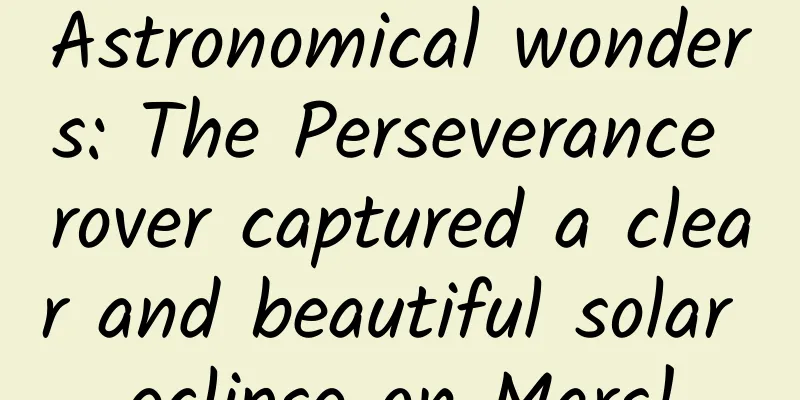Astronomical wonders: The Perseverance rover captured a clear and beautiful solar eclipse on Mars!

|
A solar eclipse on Earth is caused by the Earth's only natural satellite, the Moon, being sandwiched between the Sun and the line of sight of humans on Earth, blocking part or all of the Sun, making it look like a shadow is cast on the surface of the Sun; a solar eclipse on Mars is of course caused by the Martian satellite blocking the Sun and the line of sight of Mars, casting a shadow on the surface of the Sun. Mars has two natural satellites, Phobos and Deimos. Phobos is called Phobos in English. It is about 9,378 kilometers away from the core of Mars on average. Excluding the radius of Mars, it is only about 6,000 kilometers away from the surface of Mars. Phobos is about 13.5*10.8*9.4 (km) in size and has a mass of about 1.38*10^14 kg. Phobos' English name is Deimos. It is about 23,459 kilometers away from the core of Mars on average. It is about 15*12*11 (kilometers) in size and has a mass of about 1.8*10^15 kilograms. It is the smallest satellite in the solar system. Because of their small mass, these two satellites cannot achieve the hydrostatic equilibrium, that is, the spherical state, by their own gravity to overcome their own solid rigid body force, and therefore appear to be in an irregular potato shape. These two satellites revolve around Mars. Phobos has an orbital period of 7 hours and 59 minutes, while Mars has a rotation period of 24 hours, 37 minutes and 22.7 seconds, which is similar to the Earth. So Phobos revolves around Mars about three times a day; Deimos has an orbital period of 30 hours and 18 minutes, which means it revolves around Mars once in a little over a day. Although there are no traces of humans on Mars, there are also "sights", which are the various probes sent to Mars by humans, including 6 Mars rovers. Among these 6 Mars rovers, 5 were sent by NASA, and one was sent by China, called "Zhurong". The photo of the Martian solar eclipse was taken by the Perseverance rover sent by NASA. The rover was launched from Cape Canaveral Air Force Station in Florida, U.S., on July 30, 2020, and arrived on Mars on February 19, 2021. It landed in the Jezero Crater on Mars through a stunning "air crane" method. This clear image of the solar eclipse on Mars was taken and transmitted back by Perseverance's new generation Mastcam-Z camera on April 2, US time, when Phobos was sandwiched between Perseverance's "line of sight" and the sun. The image lasted for more than 40 seconds in total. This day is the 397th Martian day after Perseverance landed on Mars. Prior to this, Perseverance also sent back many wonderful photos of the Martian terrain. |
>>: The tooth fairy never forgets the pain in your heart
Recommend
How to attract new customers through live quiz contest?
Live quiz show was first started by HQTrivia in t...
Practical information | A comprehensive review of Toutiao products and strategy optimization
In recent years, Toutiao has developed rapidly, a...
User experience report: It’s not easy to say I love you, Apple Pay binding failed
I was surprised to hear that ApplePay has officia...
Why do we say that the seemingly powerful WeChat ecosystem has begun to wither?
Friends who are interested, please think back, in...
Android scrolling subtitle animation v3.0.1 automatically add subtitles_Taoduoduo
VIP function restrictions have been lifted Link: ...
iQIYI Verb Wireless Earphones: 25 days of ultra-long standby, lightweight and luxurious wireless sound experience
What is the most important thing for young people...
Is Chinese kelp being used by Japanese companies to pass off as Japanese products?
A few days ago, I saw a news report that a Japane...
After 2 years, Android still hasn't found a better gesture control than iOS
Google pushed the Android Q Beta 3 test system up...
Don’t be scared by them when you visit the night market on National Day…
During the National Day holiday, no matter which ...
Here are all the ways to improve your APP’s monetization capabilities!
How can an app with hundreds of thousands, million...
Analysis of the copywriting routines for highly effective Facebook advertising!
Are you facing this dilemma? You have spent a lot...
A Taizhou businessman chartered a flight to return to China for treatment of COVID-19 at RMB 2.7 million, and a Ghanaian who was diagnosed with COVID-19 chartered a flight to return to China for treatment
In the past two days, a piece of news has attract...
Should I choose wire braces or invisible braces? Here is a complete guide to orthodontics!
What is orthodontics? What are the main processes...
How to use Xiaohongshu to accurately attract traffic?
Traffic generation has always been the beginning....
Using data from 41 solar occultations, the mystery of Saturn's rings was finally discovered?
Sun reveals secrets of Saturn's rings Saturn&...









